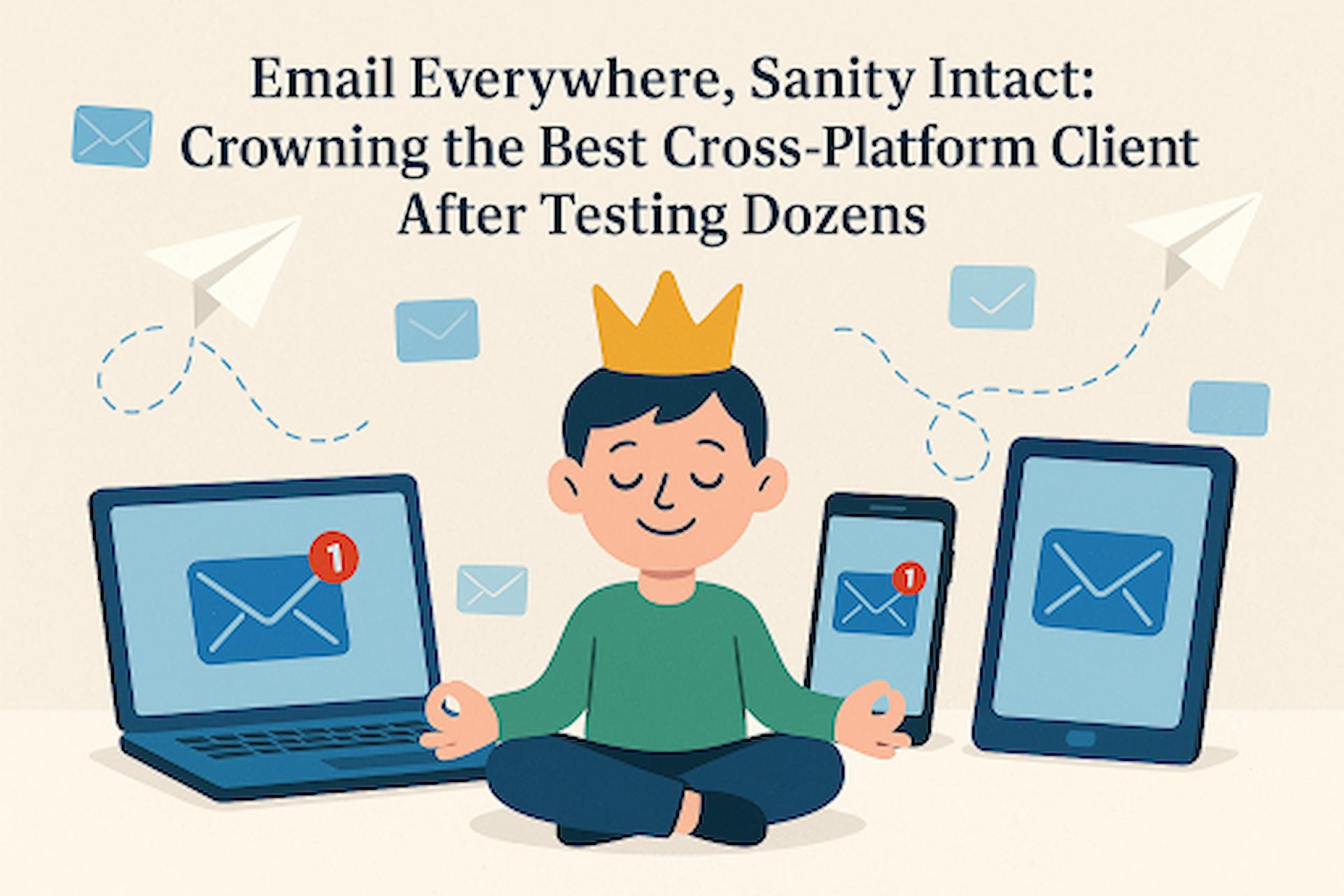Email. It’s the digital backbone of our professional and personal lives. Yet, managing it across multiple devices the work desktop, the personal laptop, the phone in your pocket, the tablet on the couch can often feel less like seamless communication and more like a chaotic juggling act. Different interfaces, missing features, and synchronization headaches are common frustrations. Wouldn’t it be wonderful to have one consistent, powerful, and reliable email experience, no matter what screen you’re looking at?
That was my mission. Frustrated by the fragmentation, I embarked on a quest to find the undisputed champion of cross-platform app development services for email clients. I dove deep, testing dozens of applications across Windows, macOS, Linux (where available), iOS, and Android. I scrutinized their features, judged their interfaces, timed their performance, and considered their privacy implications. It wasn’t just about finding an app; it was about finding the app that brings order to the email chaos. After weeks of rigorous testing, comparing, and note-taking, I have a winner to announce. But first, let’s explore why this matters so much in our modern, multi-device world.
The Multi-Device Maze
In today’s hyper-connected environment, operating solely on one device is a rarity. We start drafting an email on our work computer, reference it on our phone during the commute, and perhaps add final touches on a personal laptop or tablet in the evening. Using the native mail app on each platform (like Apple Mail on macOS/iOS and Windows Mail) or relying solely on webmail (like Gmail or Outlook.com in a browser) quickly reveals inconsistencies. What happens when a feature you love on desktop, like advanced email templates or specific integrations, simply doesn’t exist on the mobile version? Or when the user interface shift is so jarring it slows you down?
This fragmentation leads to inefficiency and frustration. You waste time learning multiple interfaces, searching for features that aren’t there, or dealing with synchronization delays. A true cross-platform email client solves this. It aims to provide a unified experience, ensuring that your folders, tags, signatures, settings, and crucially, your workflow, remain consistent whether you’re using a mouse and keyboard or tapping on a touchscreen. This consistency saves time, reduces cognitive load, and ultimately makes managing the never-ending stream of emails significantly less stressful. The goal is seamless transition, allowing you to pick up exactly where you left off, regardless of the device at hand.
Operation Email Freedom
Finding the “best” is subjective, but a structured approach helps ensure fairness and comprehensiveness. My testing wasn’t a casual glance; it was a deep dive driven by a clear set of criteria applied across multiple platforms (Windows 11, macOS Sonoma, iOS 17, and Android 14 primarily). I connected the same set of email accounts (Gmail, Outlook/Microsoft 365, and a standard IMAP account) to each client to ensure a level playing field.
My evaluation focused on several key pillars:
- Platform Availability & Consistency: Did the client truly work across major desktop and mobile OSes? How consistent was the look, feel, and feature set between platforms?
- User Interface (UI) & User Experience (UX): Was the interface intuitive, clean, and efficient? Was it easy to navigate, compose emails, and manage folders? Did it feel modern or dated?
- Core & Advanced Features: Beyond sending/receiving, what did it offer? I looked for unified inboxes, advanced search, snooze functionality, send later scheduling, email templates, calendar integration, support for multiple accounts, smart folders/filtering, and integration with other productivity tools.
- Performance & Reliability: How quickly did the app launch? How fast was searching and syncing? Did it consume excessive system resources (RAM/CPU)? Was it stable, or prone to crashes and bugs?
- Security & Privacy: What security features were offered (e.g., encryption support, phishing warnings)? Crucially, what was the privacy policy? How was user data handled, especially for clients using intermediary servers for features like push notifications or snoozing?
- Pricing & Value: Was it free, paid, or freemium? If paid or freemium, did the cost justify the features offered?
I used each contender as my primary email client for at least a couple of days, actively engaging with all its core features across different devices to get a genuine feel for its strengths and weaknesses in real-world usage.
A Glimpse into the Arena
The email client market is crowded, ranging from established giants to nimble newcomers. During my testing, several applications stood out, even if they didn’t ultimately take the top spot. Familiar names like Microsoft Outlook (the desktop version, not just the web app) offer deep integration with the Microsoft ecosystem, which is a major plus for Office 365 users, though its cross-platform consistency outside of Windows/Mac and mobile can be debated, and its interface can feel dense.
Thunderbird, the venerable open-source option from Mozilla, remains a powerhouse for customization and privacy-conscious users, especially on desktop (Windows, macOS, Linux). Its feature set is robust, and its commitment to open standards is commendable. However, its traditional interface might not appeal to everyone seeking modern aesthetics, and its mobile strategy (integrating K-9 Mail) is still evolving towards full feature parity. Mailbird presented a sleek, highly-praised interface on Windows, focusing on speed and integrations, but its lack of native macOS or Linux versions immediately disqualified it as a truly cross-platform winner in this context. Mailspring emerged as a stylish contender with a clean UI and useful features like open/link tracking and templates, available on Windows, macOS, and Linux, but its mobile apps are notably absent. These represent just a fraction of the apps tested, each bringing different philosophies and strengths to the table.
Pixels & Productivity
You interact with your email client countless times a day. Therefore, its user interface (UI) and overall user experience (UX) are paramount. A clunky, confusing, or dated interface actively hinders productivity and adds unnecessary friction to your workflow. During my tests, I saw a wide spectrum of design philosophies. Some clients opted for dense, feature-packed interfaces reminiscent of traditional desktop software, offering immense power but potentially overwhelming new users (Outlook sometimes falls into this category).
Conversely, others embraced minimalism, providing clean, aesthetically pleasing designs that prioritize focus and simplicity (Spark and Mailspring often excel here). The key is balance. A good UI should be intuitive, allowing users to find what they need without digging through layers of menus. Consistency across platforms is also vital for the UX. Switching from the desktop version to the mobile app shouldn’t feel like learning a completely new piece of software. Smooth animations, logical layouts, clear iconography, and thoughtful workflows (like composing a reply or managing attachments) all contribute significantly to a positive user experience, making email management feel less like a chore. Ease of setup, particularly adding multiple accounts, is another crucial first impression that sets the tone for the overall UX.
Beyond Send & Receive
Basic email functionality is a given. What truly differentiates modern email clients are the advanced features designed to streamline workflows and help users conquer inbox overload. A Unified Inbox is almost table stakes now, consolidating messages from all connected accounts into a single view. However, the implementation varies some simply list emails chronologically, while others offer smarter sorting. Advanced Search capabilities are critical; the ability to quickly find specific emails using multiple criteria (sender, recipient, subject, keywords, date ranges, attachments) can be a massive time-saver.
Features like Snooze (temporarily hiding emails until a later time) and Send Later (scheduling emails to be sent at an optimal time) have become indispensable for managing communication effectively. Email Templates save time for repetitive messages, while robust Calendar Integration allows for seamless scheduling and event management directly from the inbox. Smart features, such as automatic categorization (like Spark’s Smart Inbox or Gmail’s categories), help prioritize important messages. Support for integrations with other productivity tools (like Trello, Asana, Dropbox, Google Drive) further enhances workflow efficiency. The best clients offer a thoughtful combination of these features, implemented intuitively across all their supported platforms.
Under the Hood
Even the most feature-rich email client is useless if it’s sluggish, unstable, or unreliable. Performance was a key testing metric. This included measuring application launch times, how quickly searches returned results (especially across large mailboxes), and the speed of synchronization between devices and the email server. A client that takes ages to open or leaves you waiting for new emails to appear disrupts your flow. Equally important is resource consumption. A heavy client that hogs CPU cycles or eats up excessive RAM can slow down your entire system, particularly on older hardware or laptops running on battery power.
Reliability is non-negotiable. I monitored for crashes, freezes, and bugs. Syncing errors, where emails read on one device still appear unread on another or where sent messages get stuck in the outbox, are major deal-breakers. A reliable client works consistently in the background, ensuring your emails are always up-to-date and actions taken on one device are reflected promptly everywhere else. Clients that rely on intermediary servers for features like push notifications need to have robust infrastructure to ensure these functions work dependably. Overall, the winning client needed to feel snappy, stable, and trustworthy day in and day out.
Fort Knox or Leaky Faucet?
Email often contains sensitive personal and professional information, making security and privacy paramount concerns when choosing a client. Basic security features I looked for included support for standard encryption protocols (SSL/TLS) for connecting to email servers. Some clients offer built-in phishing detection mechanisms, warning users about potentially malicious links or spoofed sender addresses. For users needing enhanced security, support for end-to-end encryption, typically via PGP (Pretty Good Privacy), is a significant advantage, though often found in more specialized or technically oriented clients like Thunderbird.
Privacy policies require careful scrutiny. Many modern clients, especially those offering features like Snooze or Push Notifications that require processing data on their servers, have complex policies. It’s crucial to understand what data the client accesses, how it’s stored, who it might be shared with, and whether email content itself is read or indexed by the provider. Clients that process everything locally generally offer better privacy guarantees but may lack some cloud-dependent features. Open-source clients often provide greater transparency in this regard. Choosing a client involves balancing feature convenience with your comfort level regarding their data handling practices. Never skim the privacy policy – understand the trade-offs you are making.
The Moment of Truth
After weeks spent navigating myriad interfaces, testing countless features, and meticulously comparing performance and privacy across diverse platforms, the field narrowed considerably. Several contenders performed admirably, showcasing innovation and addressing specific user needs effectively. However, one client consistently delivered an outstanding balance of design, features, performance, and true cross-platform availability and consistency. It managed to feel both powerful and intuitive, making the often-dreaded task of email management significantly more pleasant.
The rigorous testing, the side-by-side comparisons, the real-world usage – it all pointed towards a clear winner. This application excelled in providing a seamless and unified experience whether I was on my Windows desktop, my MacBook Pro, my Android phone, or my iPad. It struck the right chord between offering advanced productivity features and maintaining a clean, approachable interface. Therefore, based on my extensive testing, the title of Best Cross-Platform Email Client goes to… Spark.
Why Spark Soared Above the Rest
Spark, developed by Readdle, consistently impressed across all key evaluation areas, making it my top choice for a cross-platform email solution. Its availability on Windows, macOS, iOS, and Android ensures true ubiquity for most users. Crucially, the experience is remarkably consistent across these platforms. The user interface is clean, modern, and intuitive, making it easy to get started, yet it doesn’t skimp on powerful features. The Smart Inbox is a standout, intelligently filtering emails into categories like Personal, Notifications, and Newsletters, allowing you to focus on what matters most.
Furthermore, Spark nails essential productivity features like Snooze, Send Later, Reminders to Follow Up, and quick replies. Its search is fast and effective, and it handles multiple accounts seamlessly within its unified inbox. Features geared towards teams, like shared drafts and private team comments on emails, add another layer of utility for collaborative environments, even if you’re just a team of one coordinating with others. Performance was generally snappy across devices, and the app felt stable throughout my testing. While its privacy policy involves using Readdle’s servers for certain features (like push notifications and smart filtering), it’s relatively transparent about its practices. The generous free tier meets the needs of most individual users, with paid options available for teams needing advanced collaborative features. It’s this well-rounded combination of design, features, performance, and true cross-platform presence that elevated Spark above the competition.
Saluting the Valiant
While Spark emerged as the overall winner in my testing, it’s crucial to acknowledge that the “best” client can depend heavily on individual priorities and specific needs. Several other applications performed exceptionally well and deserve honorable mentions:
- Mozilla Thunderbird: For users prioritizing open-source principles, deep customization, and maximum privacy control (as it processes data locally), Thunderbird remains an outstanding choice, particularly on desktop (Windows, macOS, Linux). Its extensive add-on library allows users to tailor it precisely to their needs. While its UI is more traditional and its mobile integration is a work in progress, its power and commitment to user control are undeniable. It’s completely free.
- Mailspring: If a beautiful, modern desktop-centric experience (Windows, macOS, Linux) with useful features like open/link tracking, detailed contact profiles, and templates is your priority, Mailspring is a strong contender. Its clean interface is a joy to use. The main drawback keeping it from the top spot is the current lack of official mobile applications, making it not truly “cross-platform” in the mobile sense. It offers both free and paid tiers.
- Microsoft Outlook (Desktop/Mobile): For users heavily invested in the Microsoft 365 ecosystem, Outlook offers unparalleled integration with Calendar, Contacts, Tasks, Teams, and OneDrive. Its feature set is exhaustive, especially on Windows. While its cross-platform consistency isn’t as seamless as Spark’s, and the interface can feel complex, its deep integration makes it the default choice for many enterprise and individual Microsoft users.
These alternatives highlight that the ideal email client is personal. Consider what matters most to you – be it open-source philosophy, specific integrations, aesthetic preference, or advanced tracking features – when making your final decision.
The Architects Behind the Scenes
Creating an email client that works flawlessly across Windows, macOS, iOS, Android, and sometimes Linux, while maintaining a consistent feel and feature set, is a significant technical challenge. It goes far beyond simply displaying emails. Developers must contend with different operating system APIs, screen sizes, input methods (touch vs. mouse/keyboard), notification systems, and background processing limitations. Ensuring seamless synchronization, implementing complex features like smart filtering or snooze reliably across all platforms, and optimizing for performance and battery life requires deep technical expertise.
This level of sophisticated software development often requires specialized cross-platform app development with expertise in frameworks designed to bridge these OS divides. Technologies like React Native, Flutter, Xamarin, or even custom C++ cores with native UI layers are employed to share codebases while still delivering a native-like experience. A skilled cross-platform app development company understands the nuances of each platform, enabling them to build applications like Spark or Mailspring that feel polished and performant everywhere. It’s a testament to their engineering efforts that we can enjoy such seamless email experiences across our diverse range of devices. Building truly great cross-platform applications requires dedication, skill, and a deep understanding of both shared frameworks and platform-specific intricacies.
Wrapping Up
The quest for the perfect cross-platform email client led me through dozens of applications, each with its unique strengths and weaknesses. While Spark emerged as my top recommendation due to its exceptional balance of design, features, performance, and true cross-platform consistency (Windows, macOS, iOS, Android), the journey highlighted the importance of personal needs and preferences. The ideal client for you might be the ultra-customizable and open-source Thunderbird, the Microsoft-integrated powerhouse Outlook, or the elegantly designed Mailspring, depending on your priorities regarding platform support, features, privacy, cost, and ecosystem integration.
Ultimately, the goal is to find an email client that reduces friction, enhances productivity, and brings a sense of calm to your digital communication hub. I encourage you to try out Spark, consider the honorable mentions, and perhaps test a few others based on what matters most to your workflow. The right tool can transform email from a burden into a manageable, efficient part of your day. Don’t settle for fragmented experiences, find the cross-platform ally that works best for you everywhere you work. What’s your favorite cross-platform email client? Share your experiences in the comments below!
Read More: Is Cross-Platform the Future of Mobile App Development




